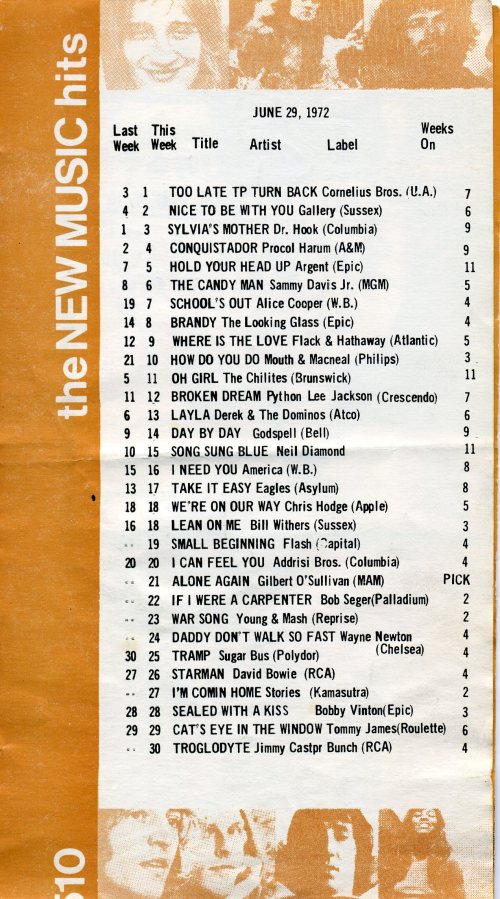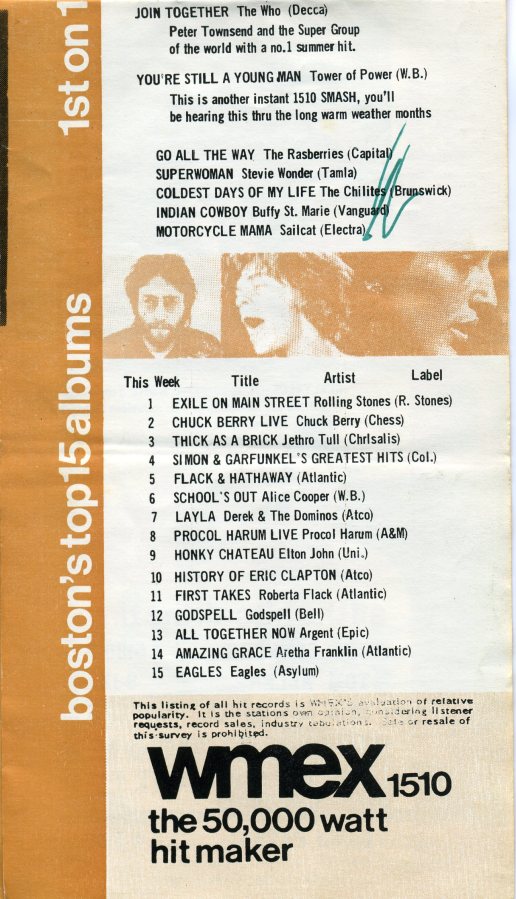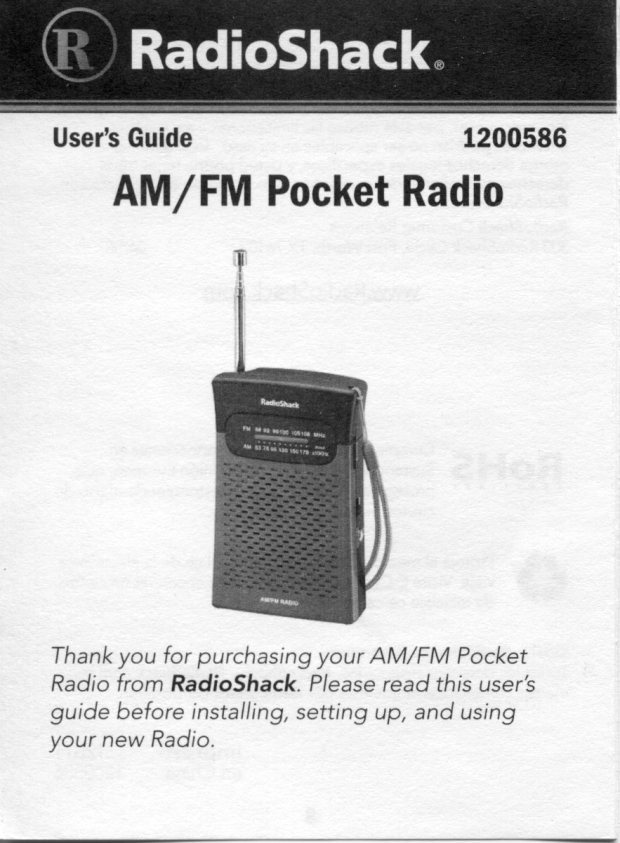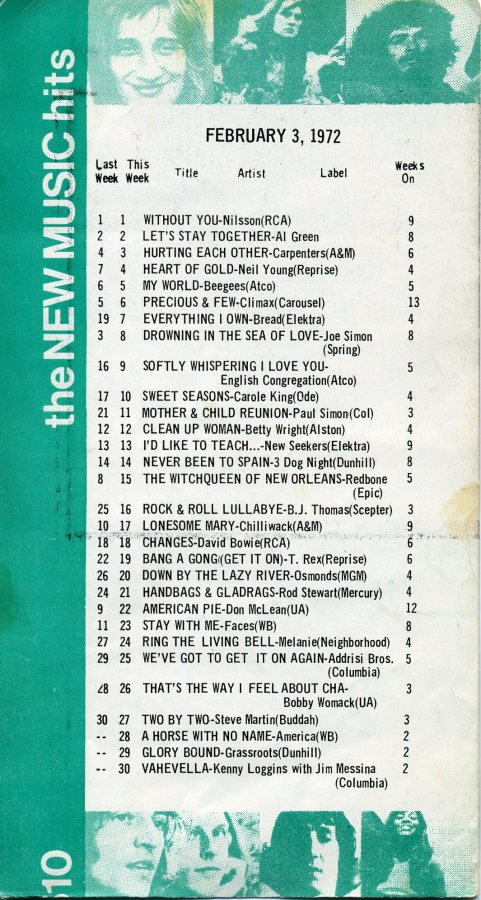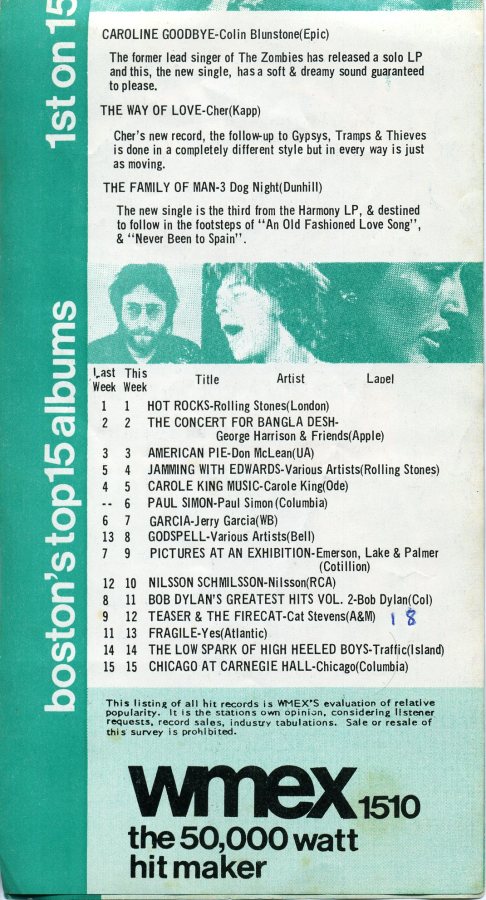It’s been said that your musical identifications and tastes are cemented at a very early age, maybe as young as fourteen. That doesn’t mean you can’t expand your sonic palette later on—I didn’t get into jazz, reggae or classical until my mid-20s or so. But in the pop music universe, the “14 Rule” hold true.
One of my lasting musical fixations is Top 40 radio in the early Seventies, from about when I was 13 to 17 years old. So imagine my delight when I came across this tome at a retro store in Portland, Maine—a little shop stuffed with old albums, cassettes, VHS tapes, comic books and pop culture knick-knacks. I took one look at the cover and said to myself, “These guys get me.”
The guys in question are brothers Don and Jeff Breithaupt. They hail from Toronto, Don is singer in the band Monkey House and Jeff is an arts-fundraiser. In the mid-80s they began to wonder what became of the 45s they collected in the previous decade and found out from Mom that they were up in the attic crawlspace, still in their original faux-denim case.
So began their deep-dive journey through a large swatch of Billboard-charting singles dating from 1971-75. They starting with a survey of early 45s by the ex-Beatles and end at the Dawn of Disco. Early in their introduction, the Breithaupts make clear that they won’t abide by any lazy notion of this era being an inferior zeitgeist. Sure, there were questionable fashions and silly fads (with some novelty records to match), but they contend (rightly) that it was also a time of a vital incorporation of the strengths of venerated Sixties. “The rock press has a good ear for innovation,” they write, “but has shown little patience with the slower process of consolidation.”
The early 70s would be the last period of the Big House notion of commercial Top 40 radio. The authors note that the continuation and expansion of the earlier Boomer rock era: this was the end days of when R&B artists, singer-songwriters, hard rockers, foreign pop bands and teenybop idols would all share space on the Billboard charts. This rich audio-cultural diversity, delivered with none of today’s virtue signaling, would soon give way to specialized radio formats, a separation process that would eventually be reflected in America’s culture wars and divisive politics.
A decade-defining case in point. The sublime “Everybody Plays the Fool,” by the Harlem-based trio The Main Ingredient, was a huge hit in 1972 and of the last of the great “advice songs” (see also Petula Clark’s “Downtown” or the Beatles “She Loves You”). From its droll spoken intro to its last buoyant chorus, this was a stone-cold classic. But it was kept from the No. 1 spot by Chuck Berry’s infantile “My Ding-a-Ling.” Such was the Seventies.
The brothers collect these disparate musical trends into a colorful collection of concise chapters, preceded by a list of ten songs which best exemplify them. For instance:
“Revoluncheon: The Sixties Continued” Includes posthumous hits by Jim (“Riders on the Storm”) and Janis (“Me and Bobby McGee”) and post-mortem anthems like “Won’t Get Fooled Again” and “Knockin’ on Heaven’s Door.”
The authors note that some Sixties-identified artists like the Who, Stevie Wonder, Paul Simon and even the Rolling Stones put out much of their best work in the early Seventies, this continuation couldn’t last forever. “The relatively unified front of the Beatles, Stones and Motown,” they note, referring to the musical Sixties, “shattered into a million Hamilton, Joe Frank and Reynoldses.”
“Dancing in the Moonlight: Seventies Pop.” Featuring Carole King’s “It’s Too Late,” Seals and Croft’s “Summer Breeze,” Rod Stewart’s “Maggie May” and Jackson Browne’s “Doctor My Eyes.” Sure it wasn’t as transformative as Monterey Pop, but only a snobby leading-edge Baby Boomer could resist the unabashed good vibes of “Dancing in the Moonlight” or this 3 Dog Night gem:
“The Sound of Philadelphia” Motown began to lose its way a little after moving from Detroit to L.A. in 1972—despite some great records by Stevie, the post-Diana Supremes and Marvin Gaye in his “What’s Going On” era. But in its place came the rise of the Philly Soul sound, led by the songwriting/producing team of Leon Huff and Kenneth Gamble. This is one of the book’s best chapters. Get ready to fall in love all over again with the Spinners, the Stylistics, the O’Jays and Harold Melvin and the Bluenotes. And let’s not forget this timeless adultery anthem by Billy Paul.
“Richard Nixon’s Greatest Hits” The era’s social protest songs were a mixed bag, but I am ready to defend the honor of the 5 Man Electrical Band’s “Signs” despite its many detractors (“the sign says you gotta have a membership card to get inside, ugh!”).
Also getting a going-over in this chapter are the likes of “Bring the Boys Home” (Freda Payne), “Give Ireland Back to the Irish” (Wings), “Fight the Power” (Isley Brothers), and the Raider’s white-guilt classic “Indian Reservation.” Sometimes the execution would get muddled and sentiments would veer more into apathy than action, despite good intentions. Ten Years After frontman Alvin Lee would “Love to Change the World” but didn’t know how so he just decided “to leave it up to you.” The authors also drill down on Chicago’s rather confounding minor hit “Dialogue (Parts 1 and 2).” Here, guitarist Terry Kath, playing a “well-informed progressive,” grills a “spoiled college kid” (sung by Peter Cetera) about his views on the world. The kid is so callow that when asked if he’s angry about the way the disastrous Vietnam War is dragging on, he plainly states that he “Hopes the president (Nixon) knows what he’s into.” And yet he somehow wins the argument by inexplicably convincing the Kath character (without providing evidence) that “everything is fine.” Wow.
By way of comparison, the Breithaupts contend that the “feminist pop” of the era was a lot more effective. Of course, Helen Reddy’s “I am Woman” gets a mention, but they are not too impressed with her “tame delivery.” Instead they rightly rave about the female singers (mostly African-American) who boldly turned the tables on the philandering macho men of the time. The politics here are mostly sexual, spawning a number of memorable, whip-smart singles like “Mr. Big Stuff” (Jean Knight), “Clean-Up Woman” (Betty Wright), “Women’s Love Rights” (Laura Lee) and my favorite, “Want Ads” by Honey Cone. In this infectious soul-groove workout, lead singer Edna Wright serves notice on her cheating-ass (ex) boyfriend by advertising for a new main squeeze in the Personals section of her local newspaper, noting that “experience in love preferred, but we’ll accept the young trainees.” Hell, yeah!
There are many other categories covered here, too many to review. Some of them are: Jazz Pop, Religious Pop, Progressive Rock, Hard Rock, Instrumentals, Story Songs (that chapter is named “Harry, Keep the Change” lol) and even “Self-Pity Pop”. This section features the lachrymose likes of “At Seventeen” (Janis Ian), “All By Myself” (Eric Carmen), “Seasons in the Sun” (Terry Jacks) and “Alone Again Naturally,” the suicide-ideation hoot by the regrettable Gilbert O’Sullivan.
But good, bad, or ugly, this music from the last great period of open-format radio do have a lasting virtue. That’s because most of the hits we were digging on back then were marked by a dogged sincerity. This can be hard to reckon with in our own ironic age. When this book came out in the mid-90s, the Seventies were enjoying a moment, but not for all the right reasons. “Generation Xers find it easy to laugh at everything,” the brothers wrote in ‘96, “they aren’t used to pop culture that wants to be taken at face value.”
This recalls a couple of big-charting songs of the time. First is “Brandy,” the only hit by the Jersey Shore band Looking Glass. The story of a lovelorn barmaid in a harborside tavern, this tune is sung in complete earnestness and was listened to in the same spirit as it headed to #1 in June 1972. But upon closer inspection, if was Brandy was such “a fine girl” and desired by all, couldn’t she just dump this sailor guy who has clearly stated “My love and my lady is the sea” (I mean, really). Or conversely, the sailor could finally give up on his stinky old boat, put a ring on it and, I don’t know, open a bait-and-tackle shop?
The other is the inimitable “Sweet City Woman” by the Calgary-based trio, the Stampeders. In this winsome, banjo-driven ditty, the singer hops a train heading out of the boonies to hook up with his lady friend living in town. He even mentions his banjo twice in the song and his anticipation is heightened not just by his girlfriend’s good loving but also her macaroons. Like I said, such was the Seventies. So the next time either song comes over the radio, we late baby boomers will be singing along with affection not irony. But I’m posting “Sweet City Woman” because at least the guy in that song knew when he had a good thing going!
—Rick Ouellette




